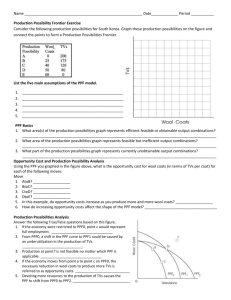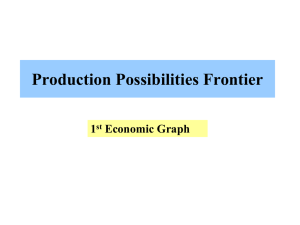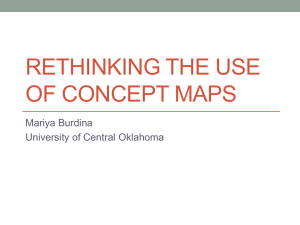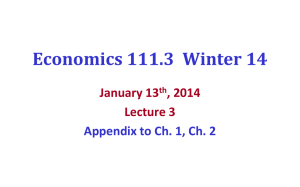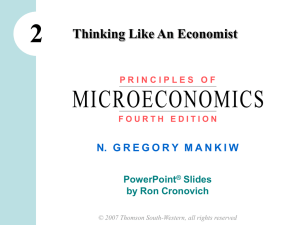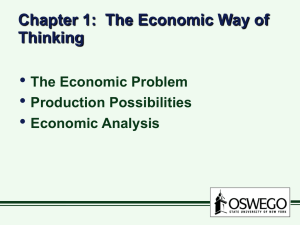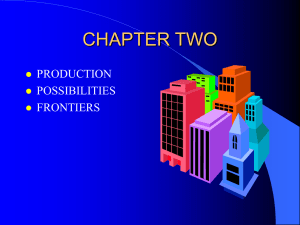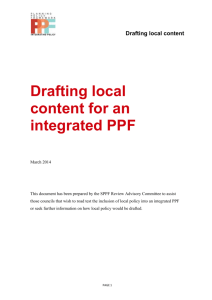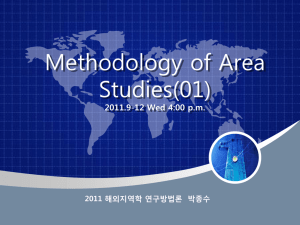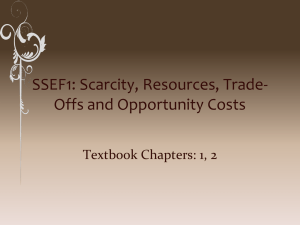File - Ms. Edlund`s Social Studies Classes
advertisement
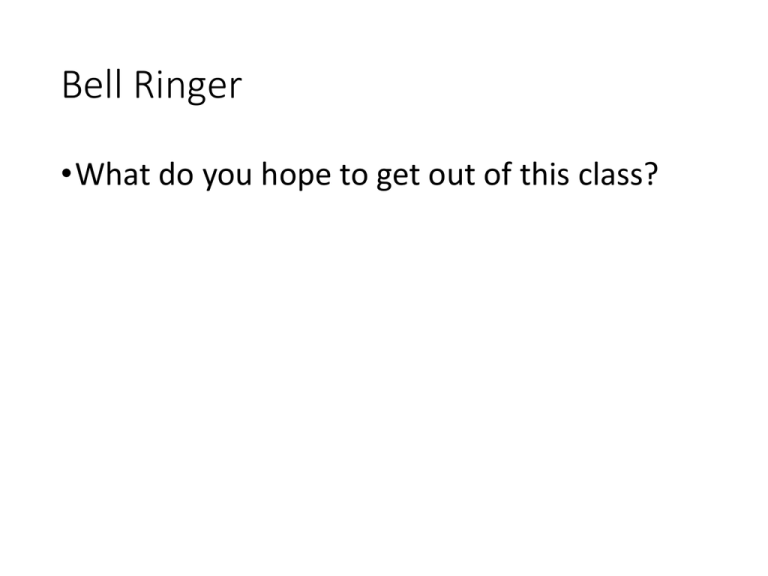
Bell Ringer •What do you hope to get out of this class? Pre-test! •Once you are done with your pretest pick up a textbook from the back of the room and check it out with Ms. Edlund. Extra Credit • State of the Union – By Friday • 1 paragraph (5 sentences) summarizing what the President said in his speech. • https://www.youtube.com/watch?v=Z8LqG_Ld0Dw • YouTube – State of the Union 2015 (New York Times) Bell Ringer • What is economics? • Economics is the science that studies the choices of people trying to satisfy their wants in a world of scarcity. Introduction to Economics • Scarcity – the condition in which our wants are greater than the resources available to satisfy those wants • Want – a thing that we desire to have • Resource – anything that is used to produce goods or services that fulfill our wants Scarcity • Wants are unlimited, resources are limited. • Scarcity exists so people need to make choices. Making Choices • Opportunity Cost – the most highly valued opportunity or alternative forfeited when a choice is made. • Every choice has costs Opportunity Costs •WHY? Why Didn’t Chris Rock go to College? • Read about Chris Rock on page 9. • What were Chris’s choices? • What was the opportunity cost of his choice? • Think about it: • What will be your opportunity cost for going to college? • What will be your total costs, including opportunity cost, for going to college? Bell Ringer • What is opportunity cost? • Opportunity Cost – the most highly valued opportunity or alternative forfeited when a choice is made. Bell Ringer • What is scarcity? • Wants > Resources Production Possibilities Frontier • A graphic representation of all possible combinations of two goods that an economy can produce. • Choice and the PPF • Scarcity and the PPF • Opportunity Costs and the PPF PPF • You are becoming a producer of triangles or squares. • Instructions: • Cut out and Glue together the Resource Strip. • Decide if you would rather produce squares and/or triangles. • Cut out the individual squares or triangles you decide to produce. PPF and Scarcity • The Production Possibilities Schedule represents all the production alternatives that are possible. • The Curve itself shows the scarcity with in society. • There is a limit to what we can produce with our given resources. • Remember that scarcity is the condition where there are not enough resources to satisfy all of our wants. PPF and Choice • How many triangles did you produce? • How many squares were you able to produce? • A society has to choose how many squares and triangles to produce. • With our resources we can’t produce unlimited amounts of both squares and triangles. PPF and Opportunity Cost • Because society has to choose what to do with our resources, we experience opportunity costs. • What is the opportunity cost of producing your first square? • Graph the production point of 6 triangles and 3 squares. Is this point possible? • Graph the production point of 4 triangles and 1 square. Is this point possible? • Is it desirable? PPF • Graph the following PPF Possibilities # of Squares # of Triangles A 0 12 B 1 10 C 2 8 D 3 6 E 4 4 F 5 0 • What could have caused the PPF to shift outward? Homework • Scarcity and PPF Packet • Due Tuesday Bell Ringer • Graph the following Production Possibilities Schedule and use it to answer the question. Guns Butter 0 15 2 12 4 9 6 6 8 3 10 0 • If the economy is currently producing 8 units of guns and 3 units of butter, what is the opportunity cost of increasing the production of butter from 3 units to 9 units? • 4 Units of Guns (move from 8 to 4 units) Quick Review • How does the PPF illustrate the concepts of scarcity, choice, and opportunity cost? • Can an economy produce at a point outside of the PPF? Why or why not? • Can an economy produce at a point inside of the PPF? Why or why not? PPF • Graph the following PPF Possibilities # of Squares # of Triangles A 0 12 B 1 10 C 2 8 D 3 6 E 4 4 F 5 0 • What could have caused the PPF to shift outward? Quick Review • How does the PPF illustrate the concepts of scarcity, choice, and opportunity cost? • Can an economy produce at a point outside of the PPF? Why or why not? • Can an economy produce at a point inside of the PPF? Why or why not? • How can a PPF get pushed outward? Thinking Economically • It is the way an economists looks at the world. • In terms of choices and opportunity costs • “Most of economics can be summarized in four words: People respond to incentives.” • Steven Landsburg • Incentive • Something that encourages or motivates a person to take action Thinking Economically • Freakonomics: Can a Ninth Grader be Bribed to Succeed? • While you watch the documentary complete the worksheet to use in a discussion. Bell Ringer • What is an incentive? • Something that encourages or motivates a person to take action Incentives • Different types of incentives: • Financial – monetary benefit • Moral – do what you believe is right • Social – social approval • Negative and Positive Incentives: • Positive Incentive – encourages a behavior (REWARDS) • Negative Incentive – discourages a behavior (PENALTIES) Resources • Also called the “factors of production” they are what people use to make goods and services. • Goods – anything that satisfies a person’s wants; tangible • Services – tasks that people pay others to perform for them; intangible Resources • Land – all the resources found in nature • Renewable – those that can be drawn on indefinitely • Nonrenewable – those resources that can not be replenished • Labor – the physical and mental talents of people • Capital – produced goods that can be used as resources for further production • Physical – tangible, human-made resources • Human – intangible, knowledge or skills a worker gains through education and experience • Entrepreneurship – the special talent that some people have for searching out and taking advantage of new business opportunities and for developing new products and new ways of doing things Homework • “Homework Exercise: Production Possibility Frontier” and p. 12 - # 2, 6, 7 and p. 27 - #3, 4, 5 • Due tomorrow • Chapter 1 Quiz!! • Come with questions about the homework
